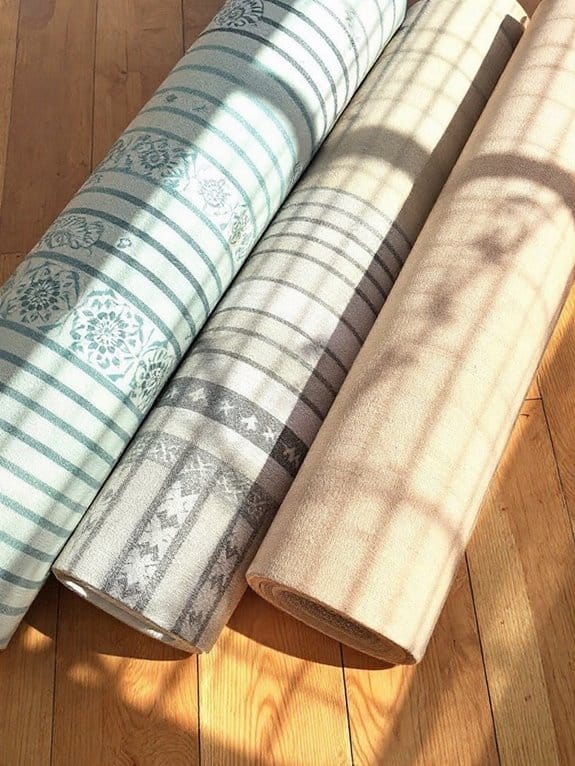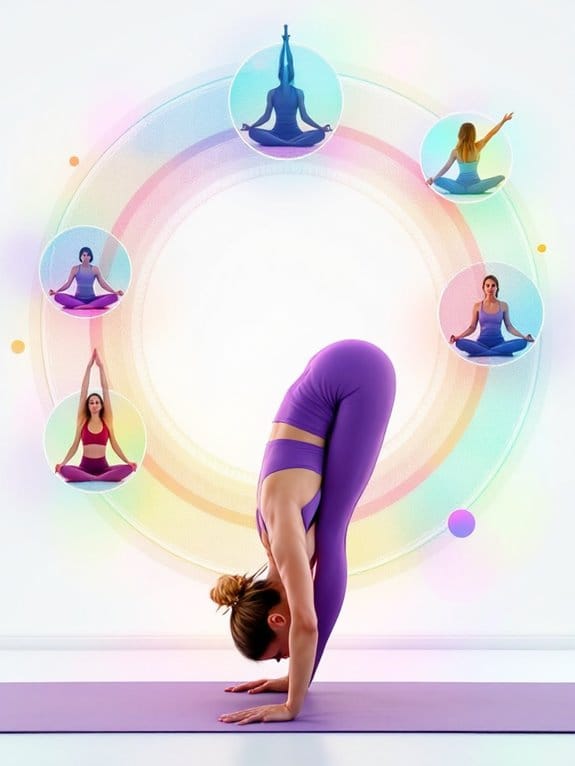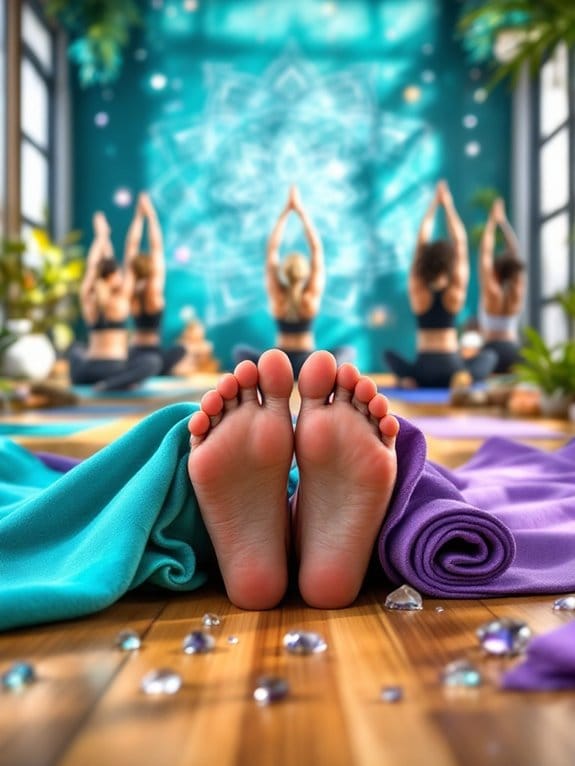Yoga instructors recommend these top cloth mats for 2025: The Jaipur Art & Rugs Cotton Yoga Rug offers eco-friendly cushioning at 5mm thick, while Gaiam's Non-Slip Hot Yoga Towel features secure corner pockets for stability during intense sessions. The Handmade Organic Cotton Mat provides a chemical-free practice surface at 78"x27". You'll want to evaluate factors like grip, thickness, and sustainability when selecting your ideal mat – each option brings unique benefits to your practice.
Key Takeaways
- Jaipur Art & Rugs Cotton Yoga Rug offers superior 5mm thickness and eco-friendly materials, making it ideal for environmentally conscious practitioners.
- Gaiam Non-Slip Hot Yoga Towel features innovative corner pockets and excellent moisture absorption for secure hot yoga sessions.
- The Handmade Organic Cotton Yoga Mat combines lightweight design with fair-trade practices, perfect for sustainability-focused yogis.
- All three mats are machine-washable and made from high-quality cotton materials, ensuring easy maintenance and long-term durability.
- Each mat provides generous dimensions exceeding standard sizes, accommodating practitioners of various heights and practice styles.
Jaipur Art & Rugs Cotton Yoga Rug (Hand-Woven, 24"x72")
- Eco-Friendly Material: Crafted from premium cotton, this yoga rug reflects our commitment to sustainable practices, providing an eco-friendly option for your fitness...
- Hand-Woven Quality: Each rug is meticulously hand-woven with care, ensuring durability and unique craftsmanship that adds character to your yoga sessions.
- Thick and Comfortable: With a generous thickness of 5mm, this rug offers unparalleled comfort and support, allowing you to fully immerse yourself in your practice without...
For yogis seeking an eco-conscious practice, the Jaipur Art & Rugs Cotton Yoga Rug stands out with its hand-woven craftsmanship. You'll appreciate the generous 24"x72" dimensions that accommodate all poses, while the 5mm thickness provides essential cushioning.
The premium cotton construction offers both durability and eco-friendliness, as it's fully biodegradable. You can maintain your rug's quality through machine or hand washing, though you'll want to take into account the 3.5-pound weight when traveling. While the grey-pink color adds style to your practice, some users note it may slip on certain surfaces, so you might need additional grip support.
Best For: Eco-conscious yoga practitioners who prefer natural materials and don't mind a heavier mat for their home practice.
Pros:
- Environmentally friendly with biodegradable cotton construction
- Generous dimensions (24"x72") accommodate all body types and poses
- Thick 5mm cushioning provides good support and comfort
Cons:
- May slip on certain surfaces, requiring additional grip support
- Heavier weight (3.5 pounds) makes it less portable
- Mixed reviews about odor issues from some customers
Gaiam Non-Slip Hot Yoga Towel with Corner Pockets
- YOGA MAT TOWEL STAYS IN PLACE: Features four corner pockets on the backside of the towel, which helps secure and hold onto the mat so it will not shift during use
- PREVENTS BUNCHING: Pockets secure the towel in place and helps to prevent the yoga towel from bunching
- GREAT FOR HOT YOGA: Towel absorbs twice as much as standard cotton and dries in half the time, so you don’t not have to worry about slipping
Sweaty yogis seeking stability will find their match in the Gaiam Non-Slip Hot Yoga Towel with Corner Pockets. This 70" x 26" microfiber towel fits standard mats perfectly and features clever corner pockets that prevent bunching during your flow.
You'll appreciate how the moisture-wicking blend of 88% polyester and 12% polyamide absorbs twice the sweat of cotton towels. The hypoallergenic material dries quickly, making it ideal for back-to-back classes. Just toss it in your washing machine when you're done.
While it's great for moderate practices, you might notice some slipping during intense sessions once the towel's fully saturated. The corners stay put, but you'll want to adjust your grip accordingly.
Best For: Hot yoga practitioners seeking a reliable, standard-sized mat towel with secure corner attachments for moderate-intensity sessions.
Pros:
- Superior moisture absorption and quick-drying capabilities compared to cotton towels
- Corner pockets effectively prevent towel from bunching or shifting during use
- Hypoallergenic microfiber material is gentle on sensitive skin and machine washable
Cons:
- May become slippery when fully saturated with sweat during intense sessions
- Tends to shed fibers after multiple washes
- More expensive than basic yoga towels without corner pocket features
Handmade Organic Cotton Yoga Mat, Non-Toxic & Chemical-Free
- 🧘Non-Toxic, Chemical-free, and All Natural Yoga Mat - Our yoga rug is made of 100% organic cotton. Unlike those made from synthetic materials, like rubber and nylon,...
- 🧘 HANDMADE ALL-NATURAL YOGA MAT - Handwoven by artisans in India, our exercise mat is strong and long-lasting. It enables us to create jobs in the country's rural...
- 🧘 Breathable and Hygienic Meditation Rug - The cotton fabric of our fitness mat has natural cooling properties. It allows your skin to breathe, making it a comfy...
Yogis seeking an eco-conscious practice will find their match in Live Well 360's Handmade Organic Cotton Yoga Mat. This chemical-free mat combines traditional artisanship with modern functionality, measuring 78 x 27 inches. You'll appreciate its lightweight 2-pound design that's perfect for both studio and travel.
The 100% organic cotton construction offers natural cooling and moisture-wicking properties you won't find in synthetic mats. While it's incredibly soft and machine washable, you'll want to pair it with grippy socks or an anti-slip mat underneath for ideal stability. The mat's handwoven construction supports fair-trade practices in rural India, so you're investing in both sustainability and social responsibility.
Best For: Environmentally conscious yoga practitioners who prioritize natural materials, sustainable production, and don't require extreme grip for hot yoga or intense flows.
Pros:
- 100% organic cotton material is breathable, naturally cooling, and machine washable
- Handwoven construction supports fair trade practices and artisan communities in rural India
- Lightweight and portable design makes it ideal for travel and outdoor practice
Cons:
- Lacks sufficient grip for advanced poses on hard floors without additional accessories
- Higher price point compared to conventional synthetic yoga mats
- May require additional anti-slip mat or grippy socks for stability during practice
Factors to Consider When Choosing a Cloth Yoga Mat

When you're searching for the perfect cloth yoga mat, you'll need to evaluate several key factors that impact your practice. You'll want to closely examine the material composition, grip capabilities, and ideal thickness (typically 4-6mm) for your specific needs. The mat's eco-credentials, cleaning requirements, and expected lifespan (usually 2-3 years with proper care) should also guide your final choice.
Material Type and Quality
The material and quality of your cloth yoga mat directly impact your practice's comfort, safety, and sustainability. When selecting your mat, you'll want to focus on high-quality, organic materials like 100% cotton that's free from harmful chemicals.
Look for handwoven construction, as it offers superior durability and a distinctive appearance that'll enhance your practice. The mat's thickness should be around 5mm to provide adequate joint support, especially during challenging poses.
You'll benefit most from materials with excellent moisture-wicking properties, which is essential if you're practicing hot yoga or tend to sweat. Choose biodegradable options that align with eco-friendly values – you're not just buying a mat, you're making an environmental choice. The best cloth mats combine durability with sustainability, ensuring they'll serve you well while minimizing their ecological footprint.
Grip and Surface Texture
Selecting a cloth yoga mat with ideal grip and surface texture guarantees your safety during challenging poses and dynamic movements. You'll want to pay close attention to the mat's moisture-wicking capabilities, especially if you're practicing hot yoga.
Look for mats with textured surfaces that feature raised patterns or strategic grooves. These designs create essential friction points between your hands, feet, and the mat's surface. While thicker mats offer more cushioning, don't choose one that's too plush – you'll sacrifice stability.
Remember to clean your cloth mat regularly with appropriate cleaners to maintain its grip. Sweat, oils, and dirt can build up over time, making the surface slippery. If you're between options, choose a microfiber mat with moderate thickness (4-6mm) and visible texture patterns for peak grip performance.
Size and Thickness
Beyond grip quality, size and thickness play pivotal roles in your cloth yoga mat's performance. You'll want to match your mat's dimensions to your height and practice style. While standard mats measure 68 x 24 inches, you might need a 72-inch length if you're taller or practice expansive poses.
When it comes to thickness, you'll find options between 3mm and 6mm. A 5mm mat offers an ideal middle ground for most practitioners. If you've got sensitive joints, opt for a thicker mat around 6mm for extra cushioning. For balance-focused practices, you'll benefit from a thinner 3mm mat that keeps you connected to the ground.
Remember to reflect on portability – thicker mats provide more comfort but add weight to your yoga bag.
Durability and Maintenance
While choosing your cloth yoga mat, understanding durability and maintenance factors will help maximize your investment's lifespan. You'll want to focus on high-quality cotton or hand-woven designs that can withstand your regular practice sessions.
Look for machine-washable options to make cleaning hassle-free. You don't want to struggle with complicated maintenance routines after each sweaty session. Thicker mats, typically around 4-6mm, offer better cushioning and tend to last longer than thinner alternatives.
If you're environmentally conscious, opt for organic cotton or biodegradable materials. These sustainable choices don't compromise on durability. Remember to wash out sweat and moisture promptly after each use – this simple habit prevents unwanted odors and extends your mat's life. A quick 15-minute air-dry will keep your mat fresh and ready for your next practice.
Eco-Friendly Manufacturing Process
Today's eco-conscious yogis should prioritize mats manufactured through sustainable processes that protect our planet. When you're shopping for a cloth yoga mat, look for those made from 100% organic cotton. These mats won't expose you to harsh chemicals during your practice.
You'll want to support companies that follow fair-trade practices in their manufacturing process. These businesses create jobs and improve living standards in production communities. Check for hand-woven options, as they're typically more durable and support traditional craftsmanship.
Consider the mat's end-of-life impact by choosing biodegradable materials. You can find this information on product labels or company websites. When you select mats from manufacturers committed to sustainability, you're helping reduce carbon emissions and supporting environmental conservation efforts.
Sweat Absorption Capabilities
Since hot yoga sessions can leave you drenched, your mat's sweat absorption capabilities become vital for safety and comfort. You'll want to look for mats made with microfiber materials, specifically those combining polyester and polyamide. These specialized fabrics can handle twice the moisture of regular cotton mats while drying considerably faster.
When you're shopping, prioritize mats with moisture-wicking surfaces that actively pull sweat away from your hands and feet. This feature isn't just about comfort – it's essential for maintaining your grip during challenging poses. Choose a mat with breathable fabric that'll help keep you cool during heated practices. Don't forget to check if it's machine washable, as you'll need to clean it regularly to maintain its absorbent properties. Regular washing prevents sweat buildup and keeps your mat fresh class after class.
Frequently Asked Questions
Can Cloth Yoga Mats Be Used Outdoors on Rough Surfaces?
Like a delicate flower in a storm, your cloth yoga mat needs protection from harsh surfaces. You shouldn't use cloth mats directly on rough outdoor terrain – they'll quickly wear down and tear. Instead, you'll want to layer your cloth mat over a thicker rubber mat for outdoor practice. If you're determined to practice outside, opt for a dedicated outdoor yoga mat with reinforced material and enhanced grip.
How Often Should I Wash My Cloth Yoga Mat?
You'll want to wash your cloth yoga mat every 4-6 practice sessions, or at least once a week if you're using it regularly. After particularly sweaty sessions, don't wait – wash it right away. Hand wash your mat in cool water with mild detergent, then hang it to air dry completely before rolling it up. For quick cleaning between washes, you can spot clean with a damp cloth and gentle soap.
Do Cloth Yoga Mats Provide Enough Cushioning for Joint Protection?
Like your trusty Walkman from back in the day, cloth yoga mats need some extra support. You'll want to place your cloth mat over a standard 4-6mm rubber mat for proper joint protection. On their own, cloth mats don't provide enough cushioning for poses that put pressure on your knees, wrists, or spine. The combination gives you both the grip of cloth and the padding you need for a safe, comfortable practice.
What's the Average Lifespan of a Cloth Yoga Mat With Regular Use?
You can expect your cloth yoga mat to last 1-2 years with regular use (3-4 times per week). You'll notice signs of wear like thinning fabric or frayed edges after about 8-12 months. With proper care – washing every 2-3 weeks and avoiding direct sunlight – you might extend its life to 3 years. However, if you're practicing daily or doing high-intensity styles like hot yoga, plan to replace your cloth mat annually.
Can Cloth Yoga Mats Be Used Effectively for Hot Yoga Classes?
You'll want to be cautious using cloth yoga mats for hot yoga. They tend to become slippery when saturated with sweat, which can be dangerous during challenging poses. If you're committed to using cloth, you'll need to layer it over a grippy rubber mat for stability. You might also want to bring small towels to place strategically at your hands and feet. For hot yoga specifically, specialized rubber mats offer better traction and safety.








